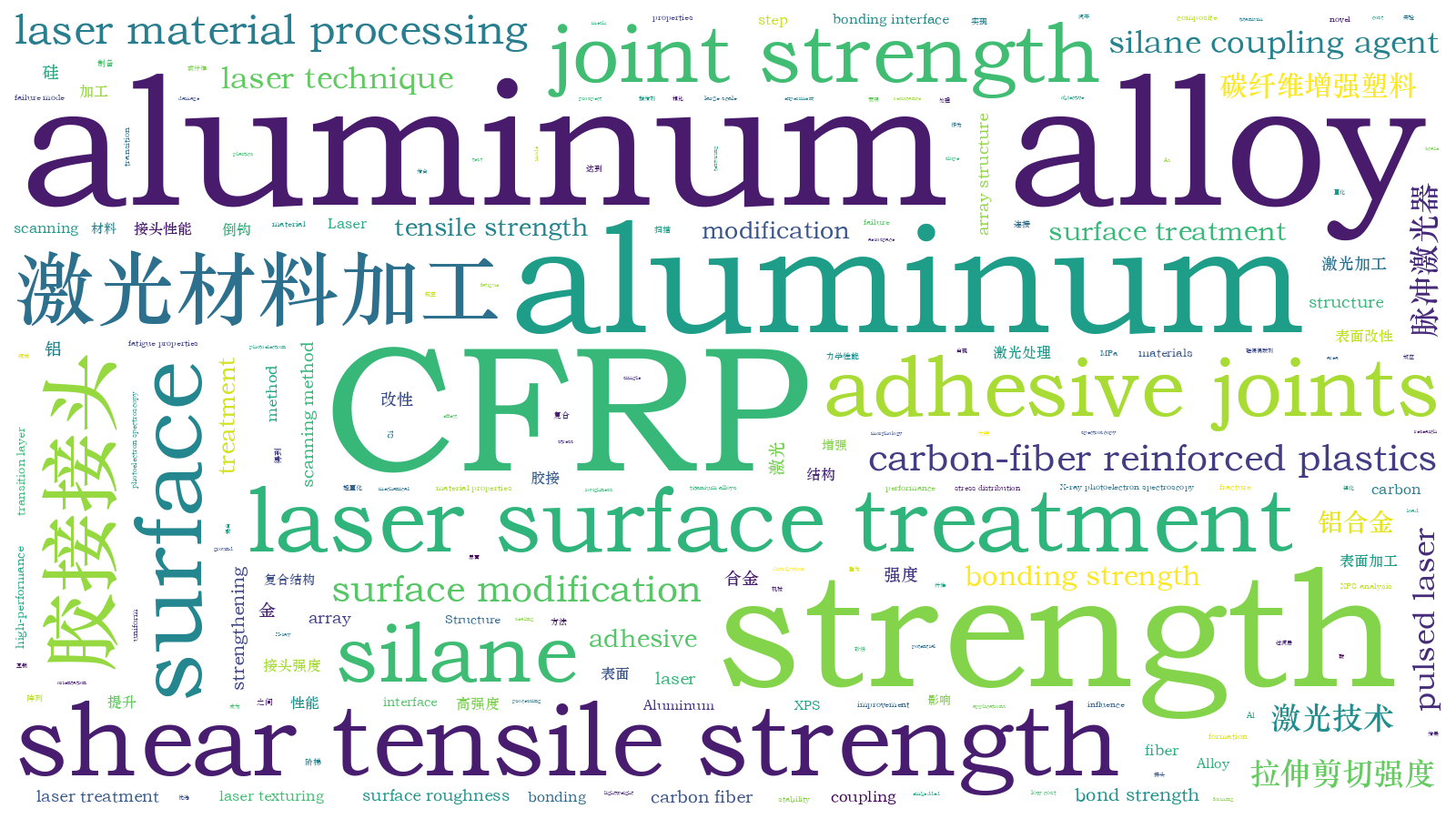表面硅烷改性和激光加工微倒钩结构对铝合金-CFRP胶接接头性能的影响  下载: 509次
下载: 509次
The accelerated advancement of contemporary society has augmented the demand for diverse material properties, including but not limited to, fatigue properties, strength, and damage resistance, in aerospace, transportation, and navigation domains. However, conventional metallic materials, such as aluminum and titanium alloys, cannot always fulfill the high-performance frame member prerequisites specified in the aforementioned sectors. Carbon fiber-reinforced plastics (CFRP), a novel material renowned for its high-performance attributes, presents a promising potential for employment in the mentioned fields. Hence, the association of CFRP with metals is an inescapable prospect. As a connection method with a simple structure and low cost, adhesive joints have special advantages such as smooth adhesive joints, good sealing, and uniform stress distribution. The pretreatment of the bonding interface had a significant influence on joint strength. Laser processing offers significant advantages due to its environmental friendliness, high repeatability and stability, and excellent surface modification ability. Prior research has shown that laser surface treatment and chemical surface modification can enhance the strength of joints between CFRP and aluminum alloy. However, there have been limited studies on the strength changes of adhesively bonded joints between CFRP and aluminum alloy under the combined influence of both treatment methods. Therefore, this study employs a laser step scanning method to create a barb array on the surfaces of both the aluminum alloy and CFRP, and then investigates the effects of the barb array structure and silane coupling agent on the strength and failure mode of the adhesively bonded joint between the two materials.
The objective of this experiment is to compare the changes in the bonding strength of the aluminum alloy and CFRP surfaces resulting from different treatment methods. Three surface treatment methods are employed: first, the surfaces of the aluminum alloy and CFRP are ground using sandpaper to increase surface roughness. Second, a barb array structure is prepared on the aluminum alloy and CFRP surfaces using a laser step-scanning method. Third, the silane coupling agent is used for surface modification. The treated CFRP and aluminum alloy surfaces are bonded together, and the tensile strength of the adhesive joint is tested using an electronic universal tester. In addition, the X-ray photoelectron spectroscopy (XPS) is employed to test the surface chemical bonds after the silane treatment.
The laser step scanning method is used to prepare a barb array with good morphology (Fig. 4). The orientation of the barb structure on the aluminum alloy surface is found to be highly uniform. In addition, the surface of the gradual slope features independent spiky structures, which can effectively increase the contact area between the adhesive and aluminum alloy, thus, enhancing the bonding strength. Both the aluminum alloy and CFRP barb arrays demonstrate better interlocking effects (Fig. 5). An aluminum alloy barb array can be embedded in a CFRP to enhance mechanical interlocking. Upon applying a tensile load, the structure of the joint exhibits enhanced tensile strength. The XPS is employed to investigate the chemical bonding components at the interface between the aluminum alloy and CFRP, which has been modified by the silane coupling agent. Following the silane treatment, a novel Si—O—Al chemical bond emerges on the surface of the aluminum alloy, and a silane transition layer is formed between the aluminum alloy and adhesive (Fig. 6). Compared to sandpaper, the strength after laser treatment increases by 24.6% to 16.7 MPa. After the silane modification, the strength increases slightly, reaching 17.4 MPa (Fig. 7). After the silane modification, the adhesive effect on the aluminum alloy surface is further enhanced, resulting in the appearance of carbon fiber tear failures (CFTs) and an overall improvement in the joint strength. However, the proportion of such carbon fiber tear failures is relatively low after silane modification, thus limiting the strength enhancement (Fig. 8).
The laser step-scanning method can form a regular barb array on aluminum alloy and CFRP surfaces and mesh perfectly. The utilization of this structure can significantly enhance the joint strength, resulting in the formation of a high-strength and highly stable adhesive joint. The XPS analysis confirms that the surface of the aluminum alloy can be effectively modified by a silane coupling agent, forming an Al—O—Si bond at the surface, which verifies the formation of a silane transition layer between the adhesive and the aluminum alloy interface following the surface modification. This not only leads to an enhancement of the joint strength, but also increases its stability. The fracture diagram shows that with an increase in joint strength, cohesion failure begins to occur on a large scale. Simultaneously, owing to the further increase in the bond strength after treatment with the silane coupling agent, a small part of the carbon fiber surface is torn, and carbon fiber tear failures begin to occur at the fracture.
The three aforementioned experimental outcomes suggest that silane modification and laser texturing can effectively enhance joint strength and form a high-strength adhesive joint, thereby strengthening the vulnerable connection between CFRP and aluminum alloy composite structural parts. This improvement significantly enhances the overall strength of composite structural parts and makes them more suitable for lightweight applications that use CFRP.
张书平, 曹宇, 杨文峰, 蔡燕, 刘文文, 朱德华, 张还. 表面硅烷改性和激光加工微倒钩结构对铝合金-CFRP胶接接头性能的影响[J]. 中国激光, 2023, 50(12): 1202203. Shuping Zhang, Yu Cao, Wenfeng Yang, Yan Cai, Wenwen Liu, Dehua Zhu, Huan Zhang. Effects of Surface Silane Modification and Laser Machining Microbarb Structure on Performance of Aluminum Alloy-CFRP Adhesive Joint[J]. Chinese Journal of Lasers, 2023, 50(12): 1202203.







